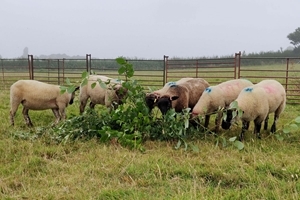 Introducing tree leaves to a sheep’s diet could play an important role in reducing harmful greenhouse gas emissions, suggests research presented at the Intercropping for Sustainability conference.
Introducing tree leaves to a sheep’s diet could play an important role in reducing harmful greenhouse gas emissions, suggests research presented at the Intercropping for Sustainability conference.
Scientists from the Game & Wildlife Conservation Trust (GWCT) monitored four groups of six Aberfield x lambs, half of which were fed around 200g of goat willow leaves each per day. When their urine patches were monitored, they found significant reductions in both nitrous oxide and carbon dioxide in those groups which fed on willow leaves. The work, part-funded by the Woodland Trust, also found lower emissions of ammonia from urine patches where lambs were fed willow.
While cutting branches to feed to livestock is labour-intensive, a move towards agroforestry with livestock (also known as silvopasture) would allow the direct browsing of coppiced trees if livestock access is managed to ensure sustainability. The use of tree fodder as an alternative source of food during periods of drought may become increasingly relevant as the climate changes, but these results suggest that a supplementary benefit of incorporating willow into grazing ruminant systems may be a contribution to climate change mitigation, as well as air quality improvement.
Defra has recently made it clear that agroforestry is eligible for support through the Basic Payment Scheme (BPS), including both silvoarable (trees planted at wide spacings and intercropped with a cereal or bio-energy crop) and silvopasture (trees combined with forage grassland and livestock production). The Committee on Climate Change estimates that agroforestry could result in carbon emissions savings of 5.9 MtCO2e per year by 2050, approximately 13% of the total current emissions from the agriculture sector.
Professor Chris Stoate undertook the research and is encouraged by the findings: “This study is a novel application of the specialist expertise and equipment we have at the Allerton Project and builds on our recent research on grass and livestock systems. The results are preliminary, but they provide an exciting indication that feeding willow leaves to ruminants may contribute to national targets for both climate change and air quality. It certainly warrants further investigation.”
Despite decreasing by 16% since 1990, farming in the UK contributes 10% of the country’s emissions. Any ambition to reach net zero, which the NFU has set as a goal for 2040, will require novel solutions. It is estimated that one kilogramme of N2O warms the atmosphere about 300 times the amount that one kilogramme of carbon dioxide does over a 100-year timescale, so any potential reduction is worth serious consideration. The benefits to air quality of the apparent reduction in ammonia is an added bonus.
Notes to editors
The Game & Wildlife Conservation Trust is an independent wildlife conservation charity which carries out scientific research into Britain’s game and wildlife. We advise farmers and landowners on improving wildlife habitats. We employ 22 post-doctoral scientists and 40 other research staff with expertise in areas such as birds, insects, mammals, farming and statistics. We undertake our own research as well as projects funded by contract and grant-aid from Government and private bodies. The Trust is also responsible for a number of Government Biodiversity Action Plan species and is lead partner for grey partridge and joint lead partner for brown hare and black grouse.
The GWCT’s Allerton Project: The GWCT’s Allerton Project is an 800 acre commercial farm business attached to a Research and Educational charitable trust. The Project was established in 1992 with the objective of demonstrating how modern efficient farming and environmental conservation can co-exist. The development of the education objectives of the Trust has expanded substantially to several thousand visitors a year including school groups, politicians and farmers, thus necessitating the construction of a larger visitor centre. The challenge of converting a disused brick cowshed into a sustainable building was given to architect Sylvester Cheung from Melton Mowbray. 60 per cent of construction costs were obtained as a grant from the Rural Development Programme for England.